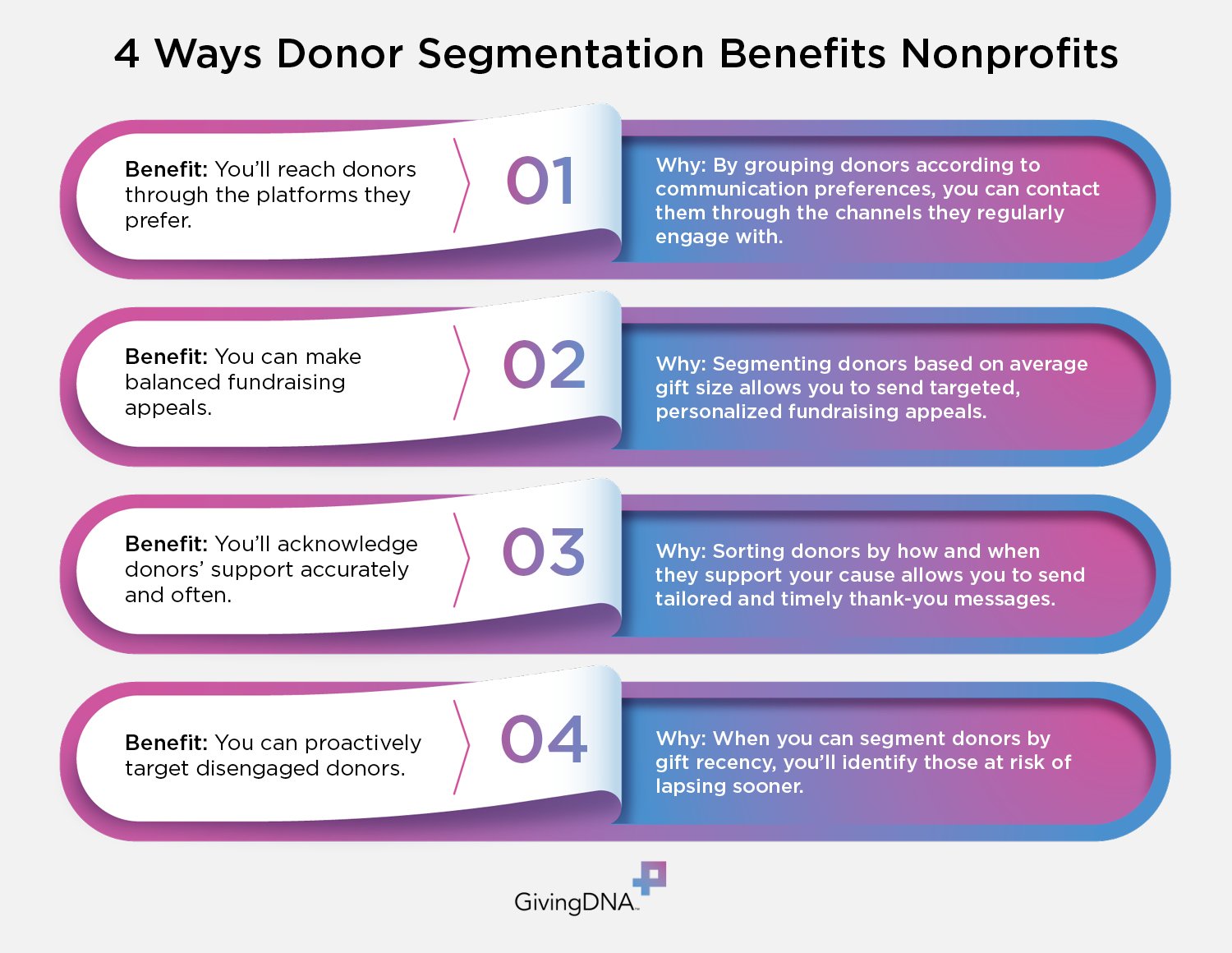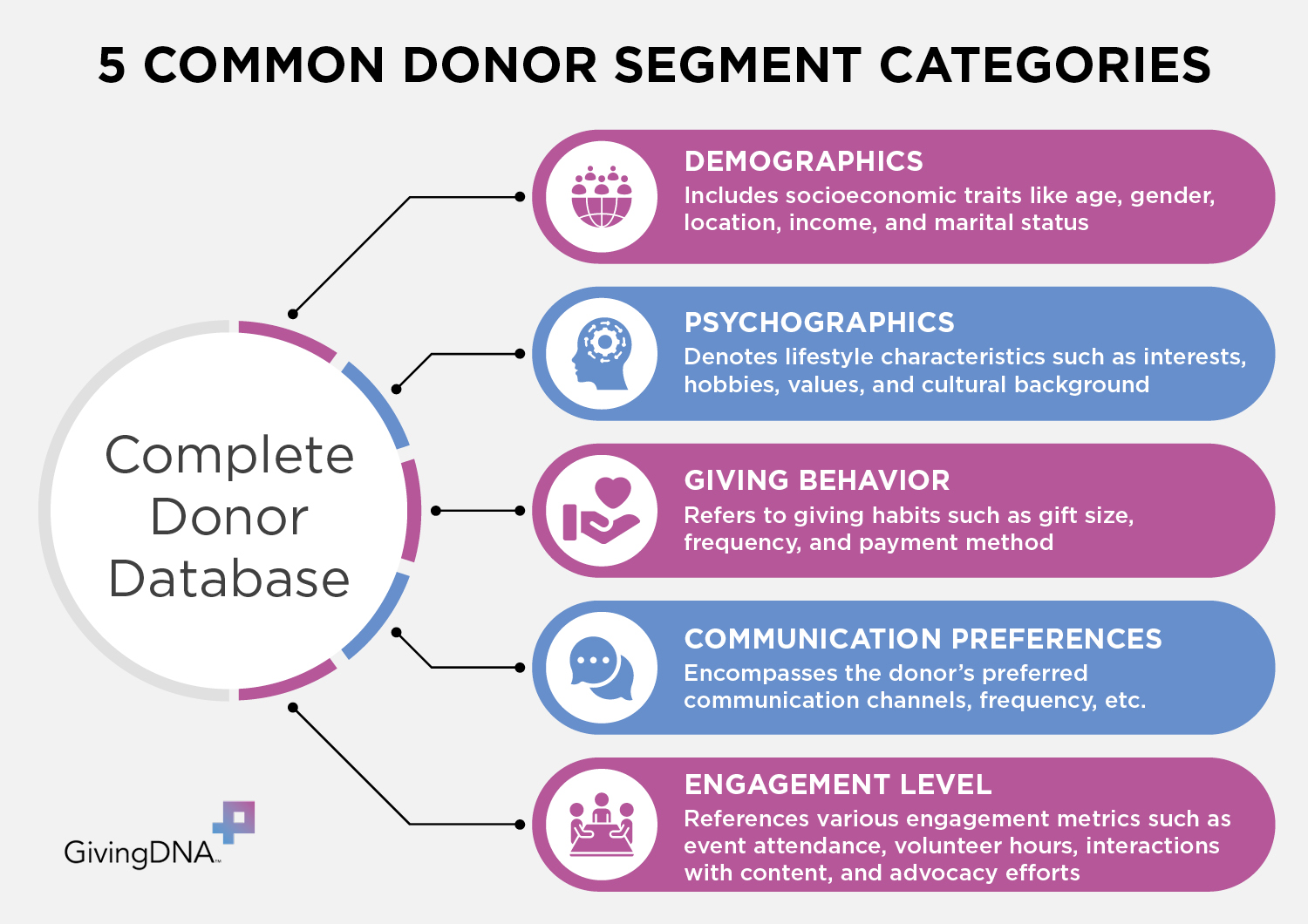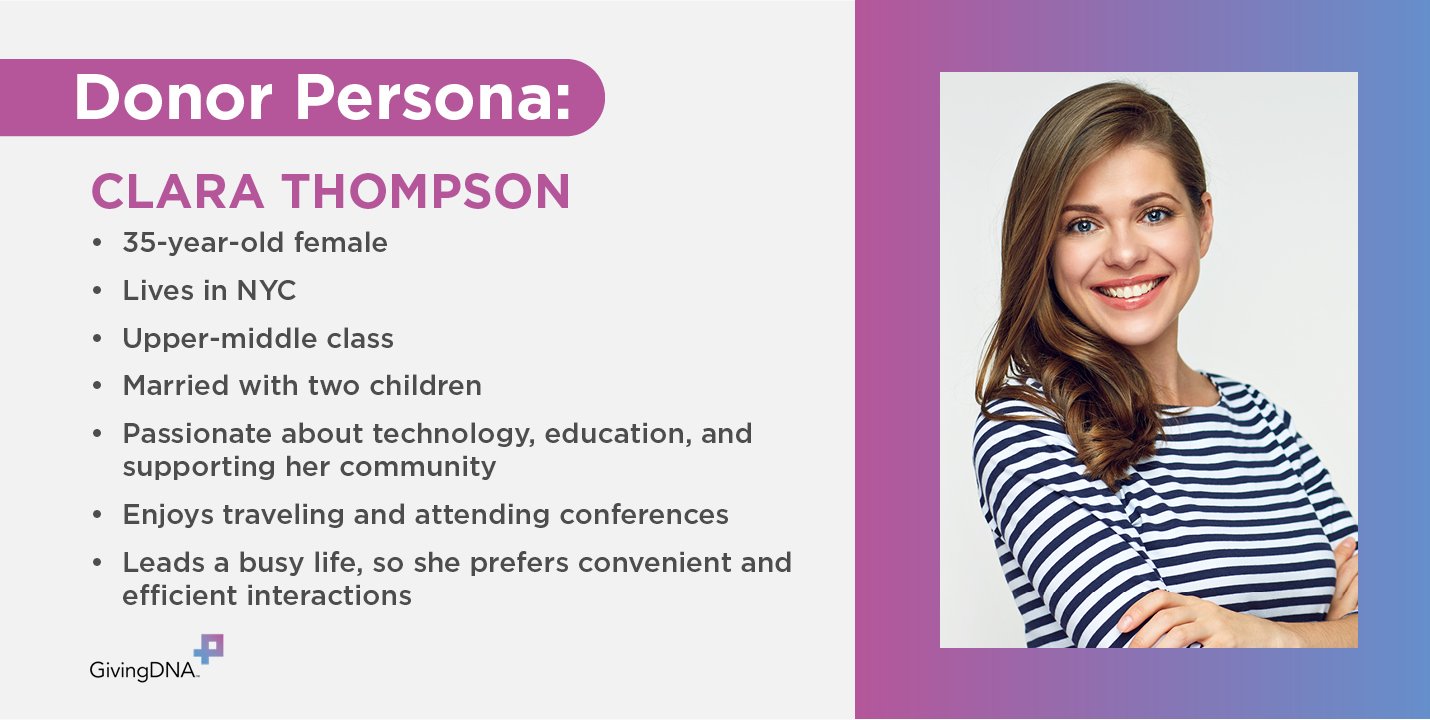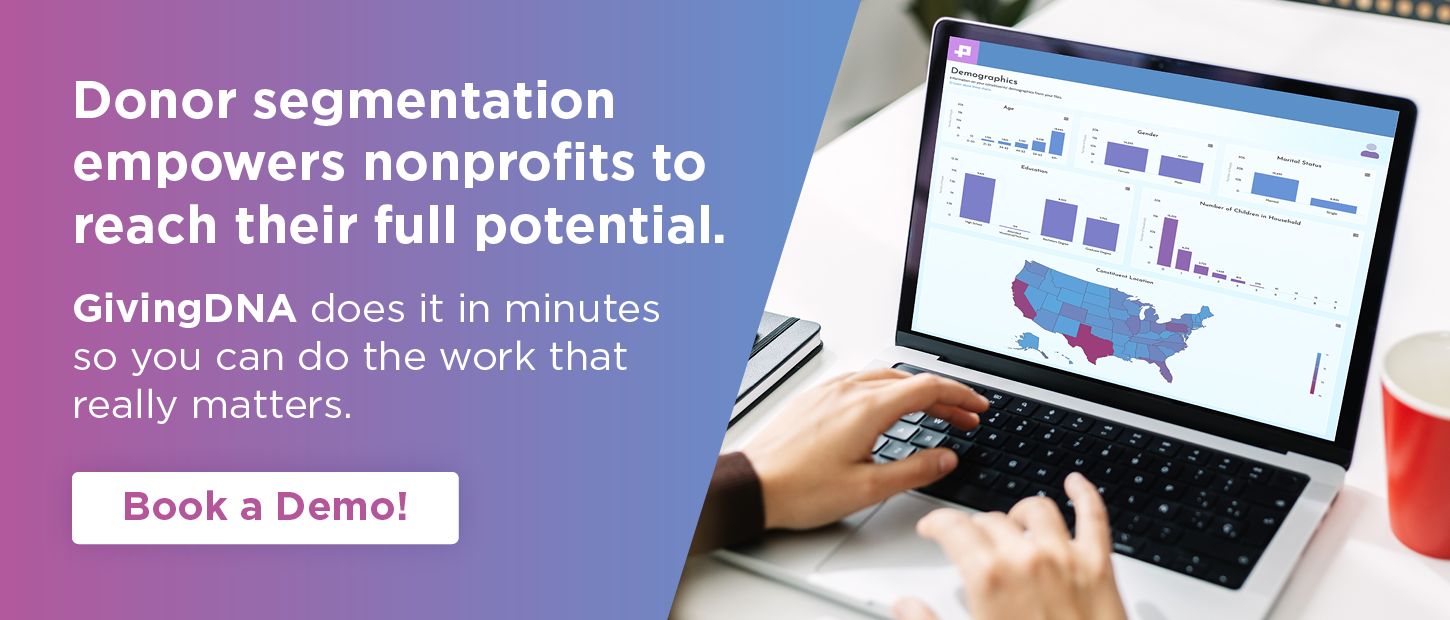Donor Segmentation: The Secret to Better Fundraising Results
It’s no surprise that fundraising is more difficult during times of economic downturn. Recent industry benchmarks show that giving started to trend downward in 2022, along with declining average donor retention rates. While these patterns can be discouraging, consider them an opportunity to improve your nonprofit’s fundraising and communication strategies.
By creating categories with your existing donor data, your organization can craft communications that resonate with each and every donor to inspire more donations for your fundraisers, help retain more donors year-to-year, and enhance your marketing ROI. In this guide, we’ll explore the basics of donor segmentation and how to use it to your advantage, including:
- What is donor segmentation?
- Why do nonprofits need donor segmentation?
- What does the donor segmentation process look like?
- What donor segment categories should nonprofits use?
- What data segmentation strategies should nonprofits use?
Before diving into the specific segmentation strategies you can use to boost campaign results, you’ll need to understand what donor segmentation is and why it’s beneficial for nonprofits. Let’s get started!
What is donor segmentation?

Donor segmentation is a strategy that nonprofits use to separate a donor base into smaller subgroups based on shared traits and characteristics. Segmentation is an important part of analyzing nonprofit data, as it allows you to organize large files into smaller, more manageable pieces. The subgroups you create are referred to as donor segments, and they can be based on a variety of categories.
For example, let’s say you work at a nonprofit whose mission is to teach young students how to use technology to better their lives, and you need to identify donors who may be willing to donate to support an upcoming workshop. You might segment donors based on their level of engagement, average gift size, interest areas, and geographic location to identify the most promising candidates.
Why do nonprofits need donor segmentation?
In addition to making your data more organized and manageable, segmenting donor data can have a variety of other benefits for your organization—particularly when it comes to creating personalized donor experiences.
Here are a few of the ways donor segmentation impacts your relationships with donors:

- You’ll reach donors where they are. Everyone has communication preferences—for example, you may prefer to call your friends and family rather than text them (or vice versa). Similarly, donors have preferences when it comes to the platforms they use to engage with your organization. Analyze the performance of past marketing campaigns to understand donors’ response rates to communication channels like social media, email, direct mail, and text.
- You can make balanced fundraising appeals. It can be hard to ask someone to contribute money to your campaigns, and knowing how much to ask for can be even more difficult. How do you know what the sweet spot is between leaving fundraising dollars on the table and asking too much of your donors? Instead of guessing, segment your donors by their average gift size. From there, make requests that perhaps push the envelope but are in line with their typical giving behavior.
- You’ll regularly acknowledge their support. Recognizing and showing appreciation for donors’ support is a crucial part of donor stewardship—and the more personal and genuine your thank-you messages are, the better. By using donor segments based on the way donors interact with your organization (e.g., volunteering vs. donating), for example, you can thank them for their engagement and even reference the project they supported. When it’s easy to reference these segments, you’ll be able to send these personalized messages in a more timely manner.
- You can proactively target disengaged donors. While no nonprofit can retain every donor, you can take a proactive rather than reactive approach to engaging supporters in your mission. Segmenting by characteristics like donation frequency, response to emails or other messages, attendance at events and volunteer opportunities, and social media interactions can reveal which donors are disengaged and at risk of lapsing. From there, your organization can employ strategies to reinvigorate their passion for your cause.
You can get creative with your donor segments, using them to achieve whatever your nonprofit’s primary goals are at the time. Let’s say your technology nonprofit needs to recruit more Gen Z supporters. You can segment donors by their generation, send existing Gen Z supporters a survey asking them how you might reach their peers, and develop a referral program to motivate them to share your cause with their friends.
What does the donor segmentation process look like?
The way your organization creates and utilizes donor segments will vary based on your needs, goals, and supporter base. If your nonprofit has a specific goal like boosting donor acquisition and retention, you might spend more time digging into your donors’ “why” than you would if your goal is simply to better categorize your donor file.
Additionally, the process will change depending on the technology you use to categorize donors. Here is what the process will look like when you choose an all-in-one fundraising analytics and data visualization tool like GivingDNA:
5 Steps to Create & Understand Donor Segments
With GivingDNA’s software, you can quickly identify which donors have the traits you are looking for and build specific, practical segments that your organization can use to achieve its goals.
Here are the steps you’ll need to follow in order to create targeted donor segments on the platform:
- Launch GivingDNA and navigate to the constituent dashboard. Make sure to confirm that your constituent and giving files have been uploaded and are accurate and up-to-date.
- Apply any filters needed to meet your criteria. Your goals may be time-sensitive or only apply to certain donors. If so, you can apply time-based filters (e.g., “gifts from the last three months”) or view donors’ first or most recent gifts.
- Explore donor segments. Once you’ve filtered data appropriately, segment your files to identify valuable insights. Additionally, you can segment by gift size, demographics, and custom parameters, and you can even access automatically generated opportunity segments.
- Analyze and filter down each segment. Let’s say you’re looking at donor segments based on age, and you want to learn more about older donors. From here, you can view information about donors, such as their income, net worth, jobs, psychographic traits, and giving behaviors.
- Use your findings to maximize your impact. It’s impossible to list all of the ways your nonprofit can leverage filters and segments to its advantage. As an example of just one use case, you might use the segments to identify older, wealthy, and highly engaged donors who are ideal major donor prospects and send them targeted messages.
Additionally, check out this video to see what the process looks like in action (and how you can create a hyper-targeted donor segment in just a few minutes):
What donor segment categories should nonprofits use?
Once your team of fundraisers understands how to segment donors, you’ll need to determine which categories to base those segments on. Here are some of the most common categories to sort your donors into in order to learn more about them and maximize revenue:

Demographics
Demographic data refers to socioeconomic information about a donor. These traits can help you understand their background which, in turn, can reveal deeper insights about the donor’s behaviors and preferences.
For example, you’d likely make different assumptions about the communication preferences of a female Gen Z college student living in a large urban area than a married, middle-aged man who occupies rural farmland.
Here are some demographic traits your organization can segment by or dig deeper into:
- Age
- Gender
- Geographic location (e.g., city, state, or region)
- Household income
- Marital status and number of children
- Education
- Occupation
While these traits may seem to be surface-level, they can reveal much more about your donors than you might think at first glance. Look for trends in behaviors and preferences that are associated with certain demographic traits to better personalize interactions with individual donors.
Psychographics
Psychographic traits are somewhat similar to demographic traits, but they focus instead on who donors are on the inside and how they live their lives.
Specifically, these traits can include donors’:
- Interests and hobbies
- Values, morals, and belief systems
- Lifestyles, including whether they are eco-conscious, health-conscious, etc.
- Religious and/or political affiliations
- Cultural backgrounds
- Personality traits (e.g., being introverted, empathic, open-minded, etc.)
Clearly, these traits can inform the ways your nonprofit interacts with donors. Here is an example of how a nonprofit can use data in this way:
Example: Using Psychographic Donor Segments to Recruit & Retain Donors
Let’s return to our nonprofit that makes technology more accessible to young people. When crafting their acquisition strategy, they might filter their existing donors by average gift size, frequency, and household income to identify their most valuable donors. From there, they’d analyze those donors’ psychographic data to create a donor persona of the ideal supporter they hope to attract.
The fictional persona should list out specific traits the donor has and how those impact how your nonprofit interacts with this type of supporter or prospect:

Clara Thompson is a 35-year-old woman living in New York City. Her income is considered to be upper-middle class in the city, and she earned a master’s degree in business from a prestigious university. She is married and has two young children.
Clara is passionate about how technology can transform the world, frequently attending tech conferences around the country to keep up with new innovations. She prioritizes her own children’s education, is passionate about bringing tech-focused learning opportunities into her community, and frequently volunteers and donates to educational causes.
Because Clara leads a busy lifestyle, she values convenience and efficiency in her day-to-day interactions. While she appreciates learning more through regular updates, she rarely has the time or bandwidth for lengthy blog posts or phone calls from fundraisers. However, she checks her email frequently and is active on social media.
Using this persona, the nonprofit’s team can put themselves in the shoes of their top donors, both current and potential, when communicating. In this case, they can skip explaining how technology and education are related as Clara is familiar with the subject. Additionally, they know that while she wants to be privy to updates about the work the nonprofit does, she’d prefer it in bite-sized pieces she can browse on her own time.
Giving Behavior
Giving behavior refers to how, when, where, and why donors give to your cause. Creating segments based on giving behavior can help you identify the donors who give the most often or at the highest amounts. Additionally, you can create segments of donors who, based on their giving behavior, may be willing to increase their donation size.
Giving behaviors that can be useful as donor segments include:
- Average gift size
- Donation frequency (e.g., one-time, monthly, or annually)
- Donation recency, or how long it has been since the last their last gift
- Donation method (e.g., online, cash, etc.)
- Type of donation (e.g., in-kind gifts of items or services vs. financial gifts)
- Affinities for specific campaigns or projects
You can also track larger giving patterns among your donors, such as times of the year when donations spike or which projects and initiatives tend to earn the most support. Tracking these trends among specific segments like mid-level and major donors can help you pinpoint opportunities to upgrade their donation amount, encourage them to join your sustainer program, or suggest other ways to get involved.
Communication Preferences
Your donors likely have a handful of communication platforms they actually interact with on a daily basis. But keep in mind that they may not want to interact with your nonprofit through all of them—for example, perhaps they are fine with emails from outside organizations but prefer to keep text messages limited to friends and family.
These preferences can come in the form of:
- Preferred communication channels, such as email, letters, social media, phone calls, text messages, etc.
- Communication frequency (e.g., would the donor appreciate or dislike weekly email newsletters?)
- Whether or not the donor opted-in for newsletter or updates
- Responses to certain messaging strategies, such as storytelling or statistical evidence
Understanding and adhering to these preferences is crucial. Sending messages through the platforms that donors use increases the chance that they will see, open, and engage with the message. Additionally, it shows that you care about their preferences and are willing to make their experience with your nonprofit a personalized one.
Engagement Level
Segmenting by engagement level is a more holistic way to track donors’ involvement with your nonprofit. By focusing solely on a supporter’s financial contributions, factors like volunteer hours can be overlooked. But, these factors can be strong indicators of a supporter's affinity to your cause.
For a more comprehensive understanding of your supporters’ engagement with your nonprofit, remember to create segments based on traits such as:
- Event attendance
- Total volunteer hours
- Volunteer impact (e.g., how many beneficiaries a volunteer worked with)
- Interactions with online content, particularly actions like “shares” that help spread awareness
- Advocacy efforts on behalf of your organization or its cause
- Serving on committees
Being aware of which donors volunteer the most or attend every event you host helps you identify your most dedicated supporters, whether they show that dedication by contributing their money or their time. These loyal supporters are the ones your nonprofit can turn to when it needs last-minute help at an event, emergency funding to support an urgent need, or assistance spreading the word about a new program to beneficiaries.
What data segmentation best practices should nonprofits follow?
Because each nonprofit's needs are so different, there are no hard and fast “rules” when it comes to donor segmentation. You can filter, segment, and analyze groups of donors based on whatever traits will help you better understand them and achieve your objectives. However, there are some basic best practices you can use to make the process run more smoothly.
For efficient and effective donor segmentation and analysis, consider following these best practices:
- Prioritize good data hygiene. Data hygiene is the process of routinely “cleaning” your database by removing outdated or inaccurate data that could impact the results of your analysis. Having clean data actually increases the value of your CRM because you can be confident that each report your team pulls is as up-to-date and accurate as possible, giving you access to the freshest insights and opportunities. Because the process of cleaning your data manually can be extremely time-consuming, consider a platform like GivingDNA that will automatically clean any uploaded databases.
- Consider the limitations of donor segmentation. Remember that each of your donors is a complex, unique individual with their own background and reasons for giving—in other words, their behaviors cannot simply be reduced to or predicted by a handful of characteristics. Analyzing a single trait or category could cause you to miss important opportunities, so it’s important to always have a complete, unsegmented version of your database to reference. By focusing too heavily on segments of major donors, for instance, you may overlook opportunities to upgrade mid-level donors or build out your sustainer program.
- Leverage effective tools that do the heavy lifting. Segmenting donors manually or with outdated software is time-consuming and requires the skill and brainpower of a seasoned data analyst. Use your resources effectively by leveraging a platform like GivingDNA that keeps your files clean, builds easy-to-understand visual dashboards, and identifies opportunities for you. For example, the platform will create an opportunity segment comprised of donors who are likely to upgrade. From there, your nonprofit can take action with targeted messages and appeals.
By following these best practices, your nonprofit can analyze its fundraising and donor data in a streamlined, organized way and rest assured that its findings are as accurate and current as possible.
Wrapping Up
Donor segmentation is a simple, effective, and often underutilized tool in each nonprofit’s fundraising toolkit. GivingDNA’s fundraising analytics software takes traditional, flat data and brings it to life. In just a few clicks, your nonprofit can segment donors quickly and easily to uncover actionable, updated insights—all without help from additional apps or data analysts.
Take full advantage of your donor data to deepen connections with supporters, fundraise more effectively, and gain a better understanding of why people choose to engage with your cause. To learn more about the power of donor data and its role in your fundraising strategy, explore these additional resources:
- Wealth Screening for Nonprofits: Key Tips and Providers. Learn more about the basics of wealth screening and explore the top tools your nonprofit can use to learn more about your donors’ giving abilities.
- Three Ways to Strengthen Your Donor Pipeline Using “Relationship Fundraising.” Check out this guide to learn more about relationship fundraising and how this strategy can help you keep donors’ passion for your mission alive.
- Master Your Mid-Level Giving Program. Your mid-level donors are perfectly poised to level up their donations. This resource explores the hows and whys behind building a mid-level giving program.




